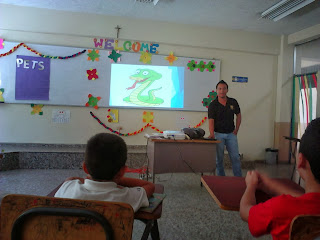Teachers: Gisselt, Cristela, Monica
Topic: Days of the week and numbers from 11-20
Vocabulary: Sunday, Monday,
Tuesday, Wednesday, Thursday
Grammar: What day is today? What is your favorite day?
The first teaching class of the third period was carried out by my
classmates Monica, Gisselt, and Cristela, who even though facing some problems,
they did a great job. In this entry, I will not talk about my case of study
because she was not there.
Monica started the class by singing the “how are you” song, which
students are already familiar with it, so they did not show problem at all. I liked how they did it because it was a new way of singing the song, and also because children enjoyed singing it. Then, she did the
warm up activity which was about playing with a spinning
wheel. By the way, it was her technique in the workshop, so she used it for the
warm up. I liked this activity because through it students were able not only
to review a single topic but some others. The topics they review were about
colors, numbers, family members, and spelling. In this activity, I could see
that children enjoyed doing it. However, I could notice some problems that
could be avoided in order to get students involved. For example, the groups
could be better done because I could see that the youngest and some older children
were in one group, and in the other there were children neither that younger
nor that older, so I consider the first team was in disadvantage with the
youngest children because most of the times they were at the top, the opposite
group got the answers first even though the youngest children knew the answers.
Nevertheless, as they are younger, they have not developed their developmental
areas in the same speed as older children. So I consider the teams needs to be
balanced in order to both teams could be at the same level.
Next, Monica presented the topic by completing a weekly planner. I was a
great way of introducing the topic because children had the
opportunity to participate
by choosing a number and finding at its back a day of the week, then Monica put
that day in the weekly planner. Once she finished all days, she start singing a
son; in this way, children could learn the vocabulary easier. Something that I
consider that could be even more interesting the activity could have been that children
tried to paste by themselves every day of the week in the weekly planner.
Although it was the presentation, by doing so she could measure students’ prior
knowledge.
Then, Gisselt continued the class and started the practice stage. One of
the activities that she did was about making a train. Through this activity
children were able to use their fine motor skills, and although at this stage
children are able to use them, not all children use them at the same speed
because some of them are starring the stage and some others are almost leaving
it, so the
youngest need more time for performing well. I think it was a great
activity in which all students got involved. However, I consider that Gisselt
could have arranged children in a better way as a semicircle because they were
arranged in a kind of line, so if she had had them in a semicircle, she could have
controlled them without being moving a lot and controlling everybody’s actions.
Another interesting activity that I consider children enjoyed a lot was about
using play dough. In it students had to paint a
day of the week
with play dough. For me it was an activity that rescued
Cristela’s control on the class since in the previous activity she had lost it,
so it helped a lot to have them busy all the time without being distracted. As
it was an activity that required using fine motor skills, and not all children
have developed a same speed, not all of them finished the activity in a hundred
percent. I saw most of the children’s works, and I saw that some older children
even were doing a second day while some of the youngest were not able to finish
just one. However, although those youngest children did not finish that
activity, they are already able to do it as older ones, but having more
time to work.
Even when some little problems took place, without doubt it was a nice
class because children learned and enjoyed the class a lot.
References:
Papalia, D., et al. A child's world. pp. 239-290. Mc
Graw Hill. USA, 2006

















